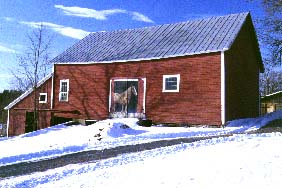TAKING
CARE OF YOUR OLD BARN
Tip # 7 - Paint It.
 A
good paint job provides both decoration and protection. Unless you have
an early barn with rough vertical board siding that was never meant to
be painted, painting is one of the best ways to preserve the exterior of
your barn by protecting it from moisture penetration. If you prepare the
surfaces thoroughly and use a good quality paint, you will be rewarded
with a paint job that will last ten years or more.
A
good paint job provides both decoration and protection. Unless you have
an early barn with rough vertical board siding that was never meant to
be painted, painting is one of the best ways to preserve the exterior of
your barn by protecting it from moisture penetration. If you prepare the
surfaces thoroughly and use a good quality paint, you will be rewarded
with a paint job that will last ten years or more.
The traditional red and ochre paints
found on many barns became widely available in Vermont by about 1850. Made
with locally produced iron oxide earth pigments and linseed oil, the paints
were relatively inexpensive, and it became fashionable on farms throughout
the region to have a red barn contrasting with the white farmhouse. At
the end of the century, shingled barns stained dark green or brown became
fashionable on gentlemen's farms. In the twentieth century, red, white,
and yellow have been the colors of choice of most farmers, often with the
trim in a different color.
Before you paint make sure to
inspect where the old paint has failed to see if there are indications
of other problems. Paint
that is peeling in large flakes down to bare wood usually indicates a moisture
problem that should be fixed before repainting. Roof and flashing leaks
or unprotected openings that let water into the walls are the likely causes.
If the problem is near the base of walls, it may indicate sill decay or
contact with the ground that wicks water into the wall. If only the top
layer of paint is peeling away, the surface was probably not properly prepared
before the last painting. It is normal for paint to wear away in small
flakes, especially on the sunny south and west sides of the building.
Preparing the surface for painting
is almost as important as painting itself. Remove loose paint chips
and dust from all surfaces. A sharp hand scraper works best with loose
paint. Do not use torches to remove paint because they may cause a fire.
Gentle power washing may be effective if surfaces are allowed to dry several
days before painting. Avoid abrasive paint removal methods such as sanding
or sandblasting, which will damage the wood and may create dust hazards.
Many older paints contain lead
pigments, which are a potential health hazard. As you remove paint
by washing or scraping, make sure no living creature will ingest or inhale
lead dust. Children and pregnant women should not risk any exposure.
Catch paint chips in a drop cloth and dispose of them properly.
Paint after all repairs are complete
and the surface is properly prepared, clean and dry.
New paint should be high quality, guaranteed to last ten years or longer.
(Cheap paint is no bargain when you consider the effort it takes to prepare
your barn for painting.) To reduce costs you can order your paint from
manufacturers in five-gallon containers. Applying paint with a hand brush
gives the most durable results. Labor can be reduced by applying paint
with a sprayer, but windows, roofing and other unpainted areas should be
carefully masked to prevent damage from overspray. A good compromise for
large barns is applying the paint with a sprayer in sections and brushing
it into the wood by hand. Plan to cover 300 to 400 square feet per gallon
of paint. Paint doors, windows, and trim with a durable trim enamel.
© 1995 Vermont Division for Historic Preservation
and Vermont Housing and Conservation Board. All rights reserved.
Forward to Barn Tip #8...
Back to the Table of Contents...
 A
good paint job provides both decoration and protection. Unless you have
an early barn with rough vertical board siding that was never meant to
be painted, painting is one of the best ways to preserve the exterior of
your barn by protecting it from moisture penetration. If you prepare the
surfaces thoroughly and use a good quality paint, you will be rewarded
with a paint job that will last ten years or more.
A
good paint job provides both decoration and protection. Unless you have
an early barn with rough vertical board siding that was never meant to
be painted, painting is one of the best ways to preserve the exterior of
your barn by protecting it from moisture penetration. If you prepare the
surfaces thoroughly and use a good quality paint, you will be rewarded
with a paint job that will last ten years or more.